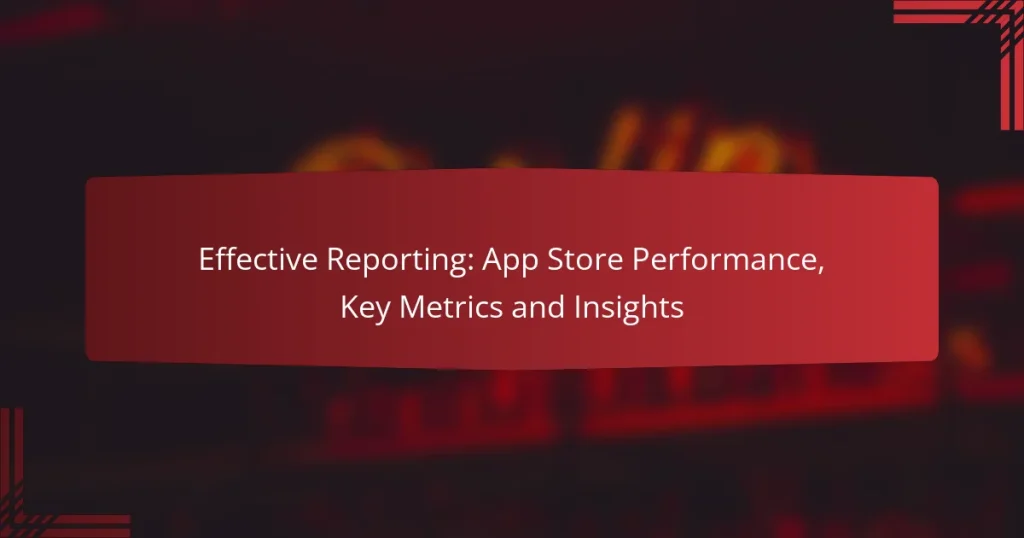App Store Analytics is essential for understanding and enhancing app performance through detailed insights into user behavior and engagement. By leveraging these analytics, developers and marketers can make informed, data-driven decisions to improve visibility and maximize revenue. Key performance metrics such as downloads, user retention, and revenue play a crucial role in assessing an app’s success in the competitive marketplace.
Monitoring Tools: App Store Rankings, Visibility Metrics and Performance Tracking
App Store Conversion Rates: Definition, Improvement Strategies and Impact
User Behavior Data: Analysis Techniques, Decision Making and Insights
Effective Reporting: App Store Performance, Key Metrics and Insights
Google Analytics: Mobile App Tracking, User Engagement, Performance Insights
Key Metrics: Downloads, Conversion Rates, Retention Rates
How can App Store Analytics improve performance tracking?
App Store Analytics enhances performance tracking by providing insights into user behavior, app engagement, and conversion metrics. These analytics help developers and marketers identify strengths and weaknesses, enabling data-driven decisions to optimize app performance.
Enhanced user engagement metrics
Enhanced user engagement metrics allow developers to understand how users interact with their app. Metrics such as session duration, daily active users, and retention rates provide a clear picture of user behavior over time. By analyzing these metrics, developers can identify features that keep users engaged and those that may need improvement.
For example, if a particular feature shows high usage but low retention, it may indicate that users are not finding long-term value in it. Regularly monitoring these metrics can lead to timely updates that enhance user satisfaction.
Increased conversion rates
Increased conversion rates are crucial for app success, as they directly impact revenue. App Store Analytics can track the journey from app store views to downloads, helping identify where potential users drop off. By optimizing these touchpoints, developers can significantly improve conversion rates.
For instance, A/B testing different app descriptions or visuals can reveal which elements attract more downloads. A well-optimized app page can lead to conversion rates in the range of 20-30%, depending on the market and competition.
Data-driven marketing strategies
Data-driven marketing strategies leverage insights from App Store Analytics to target users more effectively. By understanding user demographics and behavior, marketers can tailor campaigns that resonate with their audience. This approach increases the likelihood of attracting and retaining users.
For example, if analytics show that a significant portion of users are from a specific region, localized marketing efforts can be implemented. This might include language adjustments or region-specific promotions, which can enhance user acquisition and engagement.
What are the best tools for App Store Analytics?
The best tools for App Store Analytics provide insights into app performance, user engagement, and market trends. These tools help developers and marketers optimize their apps for better visibility and revenue generation.
App Annie
App Annie is a leading platform for app analytics that offers comprehensive data on app performance across various app stores. It provides insights into downloads, revenue, and user engagement metrics, allowing developers to track their app’s success over time.
One of its key features is market intelligence, which helps users understand competitive positioning and market trends. App Annie is particularly useful for identifying growth opportunities and optimizing marketing strategies based on real-time data.
Sensor Tower
Sensor Tower specializes in app store optimization (ASO) and market intelligence, offering tools to analyze app performance and user acquisition strategies. It provides data on keyword rankings, user reviews, and competitor analysis, enabling developers to enhance their app visibility.
With features like Store Intelligence and Ad Intelligence, Sensor Tower helps users make informed decisions about marketing spend and user engagement tactics. This tool is beneficial for both new and established apps looking to improve their market presence.
Google Play Console
The Google Play Console is an essential tool for Android developers, providing detailed analytics on app performance directly from the Google Play Store. It offers insights into user demographics, app ratings, and crash reports, helping developers understand how their app is performing in the market.
Additionally, the console allows for A/B testing of app listings and features, which can significantly improve conversion rates. Developers can also manage user feedback and respond to reviews, fostering better user engagement and satisfaction.
How to interpret App Store performance metrics?
Interpreting App Store performance metrics involves analyzing various data points to understand how well an app is performing. Key metrics include downloads, user retention, and revenue, which provide insights into user engagement and financial success.
Understanding download trends
Download trends indicate how many users are installing your app over time. Monitoring these trends helps identify peak periods, such as during marketing campaigns or seasonal events, and can guide future promotional strategies.
To analyze download trends effectively, compare daily, weekly, and monthly data. Look for patterns that correlate with changes in marketing efforts or app updates. This can help you understand what drives user interest and engagement.
Analyzing user retention rates
User retention rates measure the percentage of users who continue to use your app over a specified period. High retention rates suggest that users find value in your app, while low rates may indicate issues with user experience or engagement.
To calculate retention, track how many users return after their first use, typically over 1-day, 7-day, and 30-day intervals. Aim for retention rates above 20% for the first week and above 10% for the first month, as these figures are often considered benchmarks in the industry.
Evaluating revenue performance
Revenue performance assesses how much income your app generates, whether through in-app purchases, subscriptions, or ads. Understanding revenue streams is crucial for determining the app’s financial viability and planning future investments.
To evaluate revenue, track metrics like Average Revenue Per User (ARPU) and Customer Lifetime Value (CLV). A healthy ARPU generally ranges from a few dollars to tens of dollars, depending on the app category. Regularly review these figures to identify trends and adjust your monetization strategies accordingly.
What are the key performance indicators for app success?
Key performance indicators (KPIs) for app success include metrics that help evaluate user engagement, revenue generation, and retention. Understanding these indicators allows developers and marketers to make informed decisions to enhance app performance.
Daily active users (DAU)
Daily active users (DAU) measures the number of unique users who engage with an app each day. This metric is crucial for assessing user engagement and the app’s overall health. A higher DAU indicates a strong user base and can signal effective marketing strategies.
To improve DAU, focus on user retention strategies such as push notifications, regular updates, and engaging content. Tracking DAU over time helps identify trends and the impact of changes made to the app.
Average revenue per user (ARPU)
Average revenue per user (ARPU) calculates the revenue generated per user over a specific period, typically monthly or annually. This metric is essential for understanding the financial performance of an app and can guide pricing strategies and monetization efforts.
To increase ARPU, consider implementing in-app purchases, subscription models, or targeted advertising. Regularly analyze ARPU alongside user growth to ensure that revenue strategies align with user engagement trends.
Churn rate
Churn rate refers to the percentage of users who stop using an app over a given time frame. A high churn rate can indicate issues with user satisfaction or engagement, making it a critical metric for app developers. Reducing churn is vital for maintaining a stable user base.
To lower churn rates, gather user feedback to identify pain points and enhance the app experience. Implementing loyalty programs and personalized content can also help retain users and encourage ongoing engagement.
How to optimize app listings for better visibility?
To enhance app visibility, focus on keyword optimization, compelling descriptions, and high-quality visual assets. These elements significantly influence how your app ranks in search results and attracts potential users.
Keyword optimization strategies
Effective keyword optimization involves researching relevant terms that potential users are likely to search for. Utilize tools like Google Keyword Planner or App Annie to identify popular keywords in your app’s category.
Incorporate these keywords naturally into your app title, subtitle, and description. Aim for a balance; overstuffing can lead to penalties from app stores. A good practice is to use 2-3 primary keywords and a few secondary ones throughout your listing.
Effective app descriptions
Your app description should clearly communicate its value and features. Start with a strong opening that highlights the app’s main benefits, followed by a concise list of features.
Keep the tone engaging and user-focused. Use bullet points for easy readability, and consider including a call-to-action that encourages downloads. Aim for around 250-400 words to provide enough detail without overwhelming potential users.
Visual asset best practices
High-quality visual assets are crucial for attracting users. Ensure your app icon is distinctive and representative of your app’s purpose. Use vibrant colors and clear imagery to stand out in the app store.
For screenshots, showcase key features and user interface elements. Include captions that explain what users can expect. A good rule of thumb is to use 3-5 screenshots that highlight different functionalities, ensuring they are visually cohesive.
What are the common challenges in App Store Analytics?
Common challenges in App Store Analytics include data accuracy issues, understanding user behavior, and interpreting performance metrics. These obstacles can hinder effective decision-making and strategy development for app optimization.
Data accuracy issues
Data accuracy issues arise when the information collected from app store analytics does not reflect true user behavior or app performance. Factors such as tracking errors, inconsistent data sources, and user privacy settings can lead to misleading insights.
To mitigate data accuracy challenges, ensure that your analytics tools are properly configured and regularly audited. For instance, verify that tracking codes are correctly implemented and that data is being collected from all relevant platforms, including iOS and Android.
Common pitfalls include relying solely on one data source or failing to account for discrepancies between different analytics platforms. A best practice is to cross-reference data from multiple sources to achieve a more comprehensive view of app performance.



